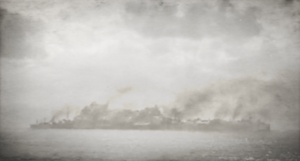Dreadnought Island breakout
The Dreadnought Island breakout, or simply the Great Deliverance, was a rescue of Allied prisoners of war and civilians conscripted into forced labor at a Quenminese coal mining facility on Thiết Giáp Hạm Island, better known colloquially as "Dreadnought Island ". On 23 August 1945, a small number of soldiers and operatives from the SOE's Crown Company, 1st Comancha Marine Raider Company, 2nd Airborne Division, the Taoyuanese Free Corps, and the Seoje network attacked the Island and liberated over 1900 prisoners.
Two days before the Raid, SOE was tasked with rescuing prominent politicians of Taoyuan, Joyonghea, Lorica, Bactieu and the Adelaidines, and those among the Quenminese dissidents in order to hasten the dismantling the Quocvangist government after the conflict's end. However, after witnessing the abhorrent conditions the POWs and civilian penal laborers were subjected to for three days, commanders of the assigned SOE units began debating on whether or not to rescue all of the prisoners. After an Allied bombing run on the island, all SOE commanders requested to high command to commit the action, which was later approved. They soon began meeting up with leaders of their respective groups of prisoners and devised a plan to escape the island with all hands possible.
At 2:00 AM QST on 23 August, the SOE, POWs and civilians proceeded to acquire arms and the prison ship named the Quà Tặng Mộng Diễm for evacuation. However, two hours into the escape, minutes after the ship was positioned, groups of Taoyuanese, Joyonghean, and Lorican laborers were discovered by nightly patrols dispatched to find the missing guards. SOE operatives alongside the armed POWs resisted the onslaught of guards for four hours, with scores of civilian laborers joining the fray. After the death of the last Director of the Thiết Giáp Hạm Mining Company, Lý Thanh Thuận, the entire facility surrendered, and the evacuees were allowed to depart the island at 9:03 AM and be received by Allied fleets who sunk a contingent of Quenminese warships led by the heavy cruiser IQNS Yên Bái an hour later.
The breakout is the largest rescue of prisoners of war and conscript laborers in the entire conflict. The rescued later became pivotal witnesses in the war effort and the Cao Khoát Trials subsequently, describing in detail the horrid and repressive conditions on Dreadnought Island. Their testimony in the latter event lead to the execution of Governor Bành Mạnh Hà who was held captive by them. The SOE operatives that participated in the breakout were awarded commendations by their respective commanders, and were given recognition by their heads of state and government. A memorial sits at the island, and the prison ship used in the breakout remains as a museum ship in Taoyuan. The operation has been depicted in several films, such as the 2017 Joyonghean film The Dreadnought Island.
